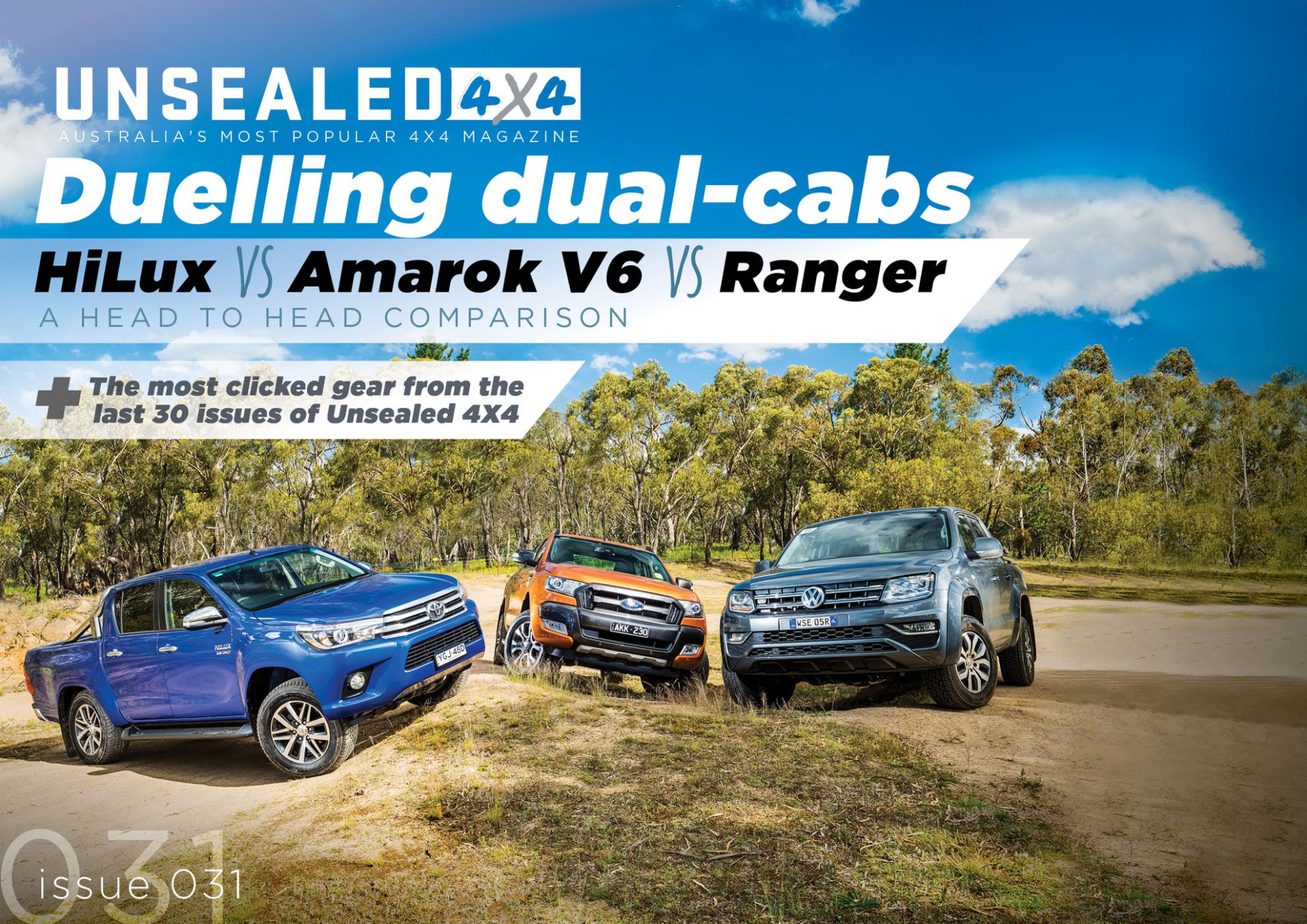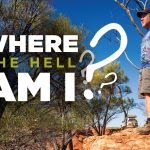Toyota’s HiLux and Ford’s Ranger have a massive sales supremacy in the 4X4 ute segment. Their latest challenge is Volkswagen’s Amarok V6, sporting the most powerful motor in the segment. We compare them, head to head.
In the world of dual-cab utes, the HiLux and the Ranger are Australia’s favourites. By a long shot. They easily are selling over 2,500 4X4 utes each per month, and are both in the running to be one of Australia’s best-selling cars overall.
When it’s such a competitive field, manufacturers spend a lot of time and money on the development of current and future models. Hell, look at how far utes have come in the past 10 or 15 years. The latest addition to this segment, and one that does up the ante quite heavily, is Volkswagen’s Amarok V6.
The Volkswagen as we know it has been around for quite a few years now, but it has been updated quite a bit. Obviously, there’s a bigger donk under the bonnet; but the 2017 Amarok is also sporting new looks and an updated interior. It’s now boasting the ribbons for most power and torque in this segment, as well as being the most expensive overall.
Has it got a crack at the title? Can it de-throne two kings? The utility royalty to Australian families, weekend warriors, tradies, and just about everything in between? Let’s put these utes through their paces, and see what happens.
OVERVIEW
What we’ve got here are the high-spec versions of each model. Toyota’s HiLux SR5+, Ford’s Ranger Wildtrak, and Volkswagen’s Amarok V6 Ultimate. The HiLux is the cheapest of the three, scraping under that $60,000 threshold with a $57,990 asking price. The Ranger goes for $60,090 – a price that was once the highest in this segment. But no more… $67,990. That’s the asking price for Volkswagen’s top-spec Amarok V6. Dimensionally, they are all pretty similar. Ford’s Ranger is the biggest and longest, with a 3,220mm wheelbase.
Top-spec models are all weighed down a little by gizmos and gadgets, so none of these units sports a one-tonne payload. The Ranger’s is the healthiest (950kg), followed by the HiLux (925kg) and then the Amarok (864kg). The Amarok also has the lowest braked towing capacity (3,000kg), beaten by 3,200kg (HiLux) and 3,500kg (Ranger). Let’s face it, though – all of these top-spec utes are destined for ‘lifestyle’ usage… to ferry family around, and to aid and abet in escapes from the city.
A figure perhaps more important for true working vehicles is the GCM: Gross Combination Mass. This dictates the maximum total weight of car and trailer, combined. The HiLux is just trumped here with 5,850kg, beaten by a 6,000kg figure for the Amarok and Ranger. This is an important one to consider: If you’re at GVM, you can’t tow at your braked limit. And if you’ve got a maximum weight trailer, your payload does become noticeably curtailed.
DRIVELINES
Four, five and six. This comparison has an interesting mix of drivelines. The smallest and least powerful is the HiLux donk: The 1GD-FTV is a 2.8-litre inline-four turbo-diesel. 130kW @ 3,400rpm and 450Nm from 1,600-2,400rpm is pretty tidy, but it’s outgunned in this company. This is pushing through a six-speed automatic gearbox. Ford’s five-cylinder donk is the biggest on test (3.2 litres), pushing out 147kW @ 3,000rpm and 470Nm @ 1500-2750rpm through a six-speed box. That’s even better, but even this gets shy in front of the Amarok’s V6. It’s a 3.0-litre unit stolen from Audi, Volkswagen and Porsche SUVs and sedans. It bristles with 165kW @ 2,500-4,500rpm, and 550Nm @ 1,500-2,500rpm. It can also ‘overboost’ in certain scenarios, to kick out an extra 15kW and 30Nm for ten seconds at a time, for 180kW and 580Nm peak output. The Amarok is the only full-time 4WD unit on this test, with an eight-speed automatic gearbox. It’s also the only model without a transfer case… instead using trick electronics and torque conversion in the gearbox for an ‘off-road’ mode.
INTERIOR
All of these units do represent the pinnacle for their models, and they’ve been updated fairly recently. For me, the least impressive interior is the HiLux. The multimedia screen is big, but looks a bit ‘tacked onto the dash’; and I really spurn the loss of proper buttons and dials. The interior has been updated, and looks quite modern; but for me, it lacks the overall class and refinement of the other contenders. On the other hand, the Ranger’s interior feels more purposeful and better laid-out. The Sync-3 multimedia setup in this new unit is really slick and easy to use. The head-up display has only an analogue speedo, which is flanked by two colour screens. Through these, you can go through just about anything.
Sporting the highest pricetag, you’d hope that the Amarok has the nicest interior. And thankfully, it does. It has a kind of unassuming quality that I really like… it’s not really trying hard to impress you, but it does so regardless. ‘Ergocomfort’ seats are brilliant, and just about worth the $8,000 spec step-up on their own. Truth be told, this feels much more like a Euro sedan than a ute.
EXTERIOR
The Amarok has been around for about six years now, making it one of the oldest kids on the dual-cab block. It’s had a facelift however, with a modernised front end. At the same time, the Ranger has been recently refreshed with the ‘PXII’ look. In terms of exterior dimensions, the Amarok is least impressive when it comes to off-road ability. The tyres fitted are of the smallest diameter, and your ground clearance is the most modest.
On the plus side, it has the biggest tray. It has the lowest deck height, and is the only one able to fit a pallet between the wheel arches. The Ranger claims the highest clearance off-road (237mm), but a long wheelbase means it needs the extra ground clearance. The HiLux has the actual best off-road clearance, with solid ground clearance (225mm), and the best approach and departure angles (31° and 26° respectively).
ON-ROAD
The HiLux is, in comparison to the others, your more ‘traditional’ ute on-road. It rides a bit jiggly when it’s unladen, and the engine works well for fairly painless progress. There’s a reasonable amount of noise coming into the cab – which certainly worsens when the engine is working hard. The gearbox is great; it’s nicely decisive, and manages to wrangle the best out of the 2.8-litre motor.
Whack 750kg of sand in the back, and that jiggly ride is quickly taken care of. Undulations do reveal underdamping of the rear shocks with this weight, and a fair bit of the perkiness of that motor is washed off. It still does a pretty good job mind you; but not as good as the others.
The performance of the Ranger is noticeably better on-road; there’s better torque available lower down, and you can notice a much more aggressive take-off. Electric steering is really crisp and easy as well. It gets progressively heavier according to your speed, which makes for a nicely involving experience. The Ranger also has the advantage of being the most tech-laden here: Adaptive cruise control and collision-sensing technology will appeal to the gizmo-buffs, adding to an overall comfortable kilometre-munching experience. Load the unit up, and the engine is forced to rev a little bit more for good progress. Peak power is only at 3,000rpm, this isn’t an engine that is a happy revver. Rather, it uses the lump of low-revs torque to get moving.
The Amarok uses lots of bottom-end torque and free-revving power to make startlingly fast progress on-road. Along with having the most power and torque, the Amarok V6 does really up the ante in terms of overall refinement. Driving this thing on-road is more reminiscent of a high-end sedan than a ute; it’s very, very quiet and comfortable. All of that power you have is very controlled – through the eight-speed gearbox, Torsen centre diff and all four wheels. It’s all very top-end. When it’s loaded up close to GVM, performance isn’t really affected much… it would probably still outperform the other utes, to be honest. The way that the suspension handles the load on-road is on par with the Ranger; quite good.
OFF-ROAD
Advanced traction control systems on all of these utes mean that the first thing that’s going to stop you off-road is ground clearance. Add a suspension lift and some slightly taller tyres, and you’ve got yourself a very capable off-roader. All of the models tested had locking rear differentials, but we chose to leave these off as much as possible to test articulation and traction control. The HiLux felt the most comfortable off-road, with good ground clearance and a nicely responsive off-road traction control system. The Ranger worked well, but was let down by a much jerkier and slow-thinking traction control system. The Ranger didn’t get stuck, but it was nowhere near as poised or controlled as the others.
The Amarok is often written off as an off-roader because of the absence of a low-range transfer case. This isn’t justified, however. A smooth and responsive traction control system works really well, combining with the Torsen diff to divert drive where it’s needed. You do have to drive the Amarok a little differently to other 4WDs off-road, feeding it a bit more throttle to keep the traction control system decisive. Where the Amarok is let down is ground clearance. Smaller tyres and a lower belly meant it was bottoming out much too soon, compared to the others.
When loaded, these units all performed much better than I thought they would. The rear suspension started working quite well, and traction was in good supply. That kind of weight does sink the back down a bit on all of the models, so you have to be conscious of reduced ground clearance towards the rear. Watch the videos to see how they all performed.
The Verdict
Who’s the best? Watch the video to find out…










